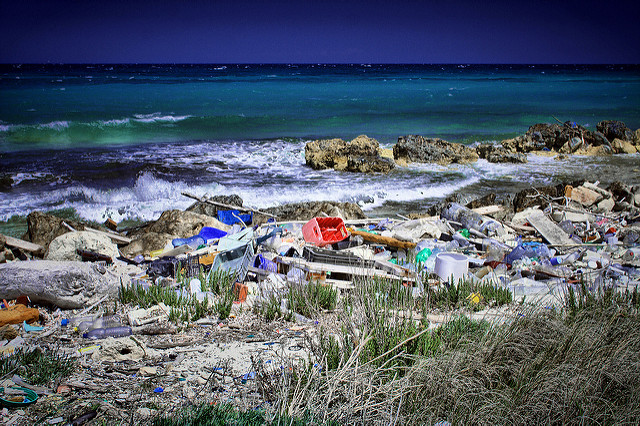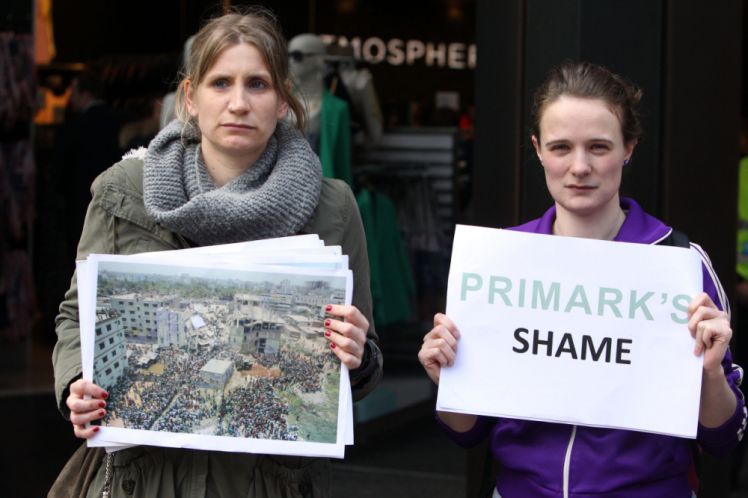Zara changes stock so quickly that that it has been coined as “mind-spinningly supersonic.” H&M made fast fashion and upscale synonymous with collaborations with some of the biggest fashion brands and icons including Versace, Alexander Wang and Beyoncé. Primark has been able to optimize its low cost strategy so much that their prices are lower than one of the most well-known fast fashion brands H&M. However, this inexpensive yet stylish clothing comes with a price besides the publicized ethics issues. The amount of waste produced by fast fashion makes it the second largest pollutant in the world with oil taking first. The cotton usage, the water needed for textile dyeing and washing and the short lifespan of clothes with fast fashion clothing only intended for ten wears before being discarded are just some of the dirty practices in fashion industry. However, there has been a shift with an introduction and acceptance of recycling, reducing and reusing fashion.
There is a lot of plastic in the ocean. Between 5.3 million and 14 million tons of plastic are released into the ocean annually. While the exaggerated myth about the Great Pacific Garbage Patch is a bit overblown, the amount of plastic in the ocean is still problematic and harmful from the long-term effects of toxic pollutants to marine life and potentially humans to the cleanup cost with an average cost of $1,500 to clean a ton of plastic beaches. With this plaguing knowledge and inspiration from Patagonia’s line of fleece jackets made from recycled plastic, Tyson Toussant and Tim Coombs created Bionic Yarn with three yarns, HLX, DPX, and FLX, made practically or completely of recycled plastic. Together with the brand recognition and resources of label G-Star, design of musician Pharrell, and eco-friendliness of Bionic Yarn, RAW for the Ocean was created as a project for transforming plastic in the ocean into stylish jeans. Bionic Yarn demonstrates the possibilities of greener raw materials in the fashion industry.

PHOTO CREDIT: FLICKR
But clothes eventually have to be replaced. Or do they? The threat of ruining clothes because of a stain have been relieved with startup brands like ODO Clothing and Eros & Psyche. Described as “self-cleaning,” ODO Clothing gets rid of odors and repels stains. A stain-resistant and waterproof skirt is offered by Eros & Psyche so wearers can remain frilly and stain-free. ODO Clothing offers jeans, tees, scarfs, and socks for men and women and Eros & Psyche’s collection has many skirt designs. Both companies will reduce the need for multiple shopping trips and provides a reduction in water usage with less laundry trips. Not to be outdone by a startup, larger retail brands also offer means to reduce clothing purchases. Rather than making customers pay for a replacement, companies like Dr. Martens, Patagonia, and L.L. Bean offer lifetime guarantees on their product that include replacing or repairing their product after normal wear and tear. A purchase at these companies is a purchase for life.
Related articles: “SUSTAINABLE FASHION – TODAY AND TOMORROW “
“RÊVE EN VERT – DREAMY SUSTAINABLE FASHION”
Upcycling is repurposing old material and making it new. A simple concept has spawned a separate sector in fashion that is dedicated creating fab fashion with upcycling. With old veteran uniforms, Sword and Plough creates bags, from backpacks to tote bags. Using premium material leftover from manufacturers, to create bags, tech sleeves and shirts. TRMTAB uses leather scraps from factories from around the world to create leather bags. Produced by Motel Rock, Motel Vintage hand picks and redesigns to create trendy designs. The phrase “another man’s trash is another man’s treasure” has been taken to heart with upcycling bringing new life to old clothing.
Quality over quantity is often a sentiment used to justify the decision to purchase one expensive garment instead of several cheap garments. As demonstrated by the examples, that statement holds true for eco-conscious brands. The cheapest jeans RAW for the Ocean offers are $210 for women and $220 for men compared to H&M whose most expensive jeans are $59.99 for women and $49.99 for men. Even lesser known brands such as ODO Clothing has premium prices with their jeans, for men and women, costing $115. However, consumers are becoming more willing to stand by ideals and pay premium pricing for socially responsible companies globally. With the raise of environmental awareness, consumers expecting corporate social responsibility and the understanding that the current practices are not sustainable, the fashion industry will soon have no choice but to use alternative means of production but also bridge the gap between eco-friendliness and affordability as well as availability.

IN THE PHOTO: PROTESTERS AGAINST PRIMAK AFTER FACTORY COLLAPSE IN BANGLADESH. PHOTO CREDIT: METRO
Whether it is to express ourselves, show our status or simply protect ourselves from the elements, the fashion industry is necessary. Regardless of if we maintain our unique fashion sense, limit our shopping, or revert back to loincloths, tunics and robes, the fashion pollution problem will not be resolved. These are merely symptoms of a greater problem, the problem of a linear economy that does not actively seek to produce zero waste and pollution. While these companies and organizations have taken large strides to limit or eliminate waste, more work still needs to be done to alleviate the burden fashion has on the planet. Rather than rush for fast fashion, it is time to appreciate clean fashion.










